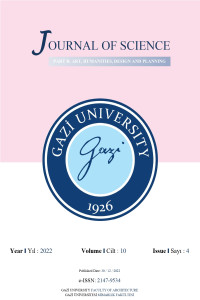Abstract
References
- Bullen, P. A., & Love, P. E. D. (2009). Residential regeneration and adaptive reuse: learning from the experiences of Los Angeles. Structural Survey, 27(5), 351–360.
- Emden C. (2010). CerModern Photos Archive.
- Conejos, S., Langston, C., & Smith, J. (2011). Improving the implementation of adaptive reuse strategies for historic buildings. In Le vie dei mercanti S.A.V.E. HERITAGE. Safeguard of architectural, visual, environmental heritage.
- Cramer, J., & Breitling, S. (2007). Architecture in Existing Fabric. London, England: Birkhauser.
- DEH, Department of Environment and Heritage. (2004). Adaptive reuse: Preserving our past, building our future. ACT: Department of Environment and Heritage, Commonwealth of Australia.
- Douglas, J. (2006). Building Adaptation (2nd ed.). Butterworth-Heinemann.
- Orbaşlı, A. (2008). Architectural conservation. London, England: Blackwell Publishing.
- Shen, L. Y., & Langston, C. (2010). Adaptive reuse potential: an examination of differences between urban and non-urban projects. Facilities, 28(1), 6–16.
- TICCIH. (2003). The Nizhny Tagil Charter for the Industrial Heritage. the Nizhny Tagil Charter for the Industrial Heritage, (July), 1–6.
- TEBC, Turkish Earthquake Building Code. (2018). Republic of Türkiye Ministry of Environment, Urbanization and Climate Change. Ankara, Türkiye.
- Uygur Architecture. (2019). Architectural drawing and photo archive. Ankara, Türkiye.
Abstract
The buildings in Türkiye reflecting the impact of industrialization originating from Europe in the 18th century and later are considered industrial heritage today. These buildings that are worth preserving are brought back to the city by the phenomenon of adaptive reuse. However, among important issues to be discussed are seismic loads which bear a great risk for industrial heritage building. Adaptive reuse of such structure focus on the building the design, repair and retrofit of structural systems. While also establishing the link between the old identities of the structures and the present one. In this study, the transformation process of the CerModern building, which is a registered industrial heritage building in Ankara, into Ankara's first modern arts center was evaluated while focusing on structural system design. The CerModern building was reviewed in terms of restoration interventions. The main purpose of the study is to comparatively examine and evaluate the authentic structural system and the designed new structural system applied.
References
- Bullen, P. A., & Love, P. E. D. (2009). Residential regeneration and adaptive reuse: learning from the experiences of Los Angeles. Structural Survey, 27(5), 351–360.
- Emden C. (2010). CerModern Photos Archive.
- Conejos, S., Langston, C., & Smith, J. (2011). Improving the implementation of adaptive reuse strategies for historic buildings. In Le vie dei mercanti S.A.V.E. HERITAGE. Safeguard of architectural, visual, environmental heritage.
- Cramer, J., & Breitling, S. (2007). Architecture in Existing Fabric. London, England: Birkhauser.
- DEH, Department of Environment and Heritage. (2004). Adaptive reuse: Preserving our past, building our future. ACT: Department of Environment and Heritage, Commonwealth of Australia.
- Douglas, J. (2006). Building Adaptation (2nd ed.). Butterworth-Heinemann.
- Orbaşlı, A. (2008). Architectural conservation. London, England: Blackwell Publishing.
- Shen, L. Y., & Langston, C. (2010). Adaptive reuse potential: an examination of differences between urban and non-urban projects. Facilities, 28(1), 6–16.
- TICCIH. (2003). The Nizhny Tagil Charter for the Industrial Heritage. the Nizhny Tagil Charter for the Industrial Heritage, (July), 1–6.
- TEBC, Turkish Earthquake Building Code. (2018). Republic of Türkiye Ministry of Environment, Urbanization and Climate Change. Ankara, Türkiye.
- Uygur Architecture. (2019). Architectural drawing and photo archive. Ankara, Türkiye.
Details
| Primary Language | English |
|---|---|
| Subjects | Architecture |
| Journal Section | Architecture |
| Authors | |
| Publication Date | December 30, 2022 |
| Submission Date | September 17, 2022 |
| Published in Issue | Year 2022 Volume: 10 Issue: 4 |


